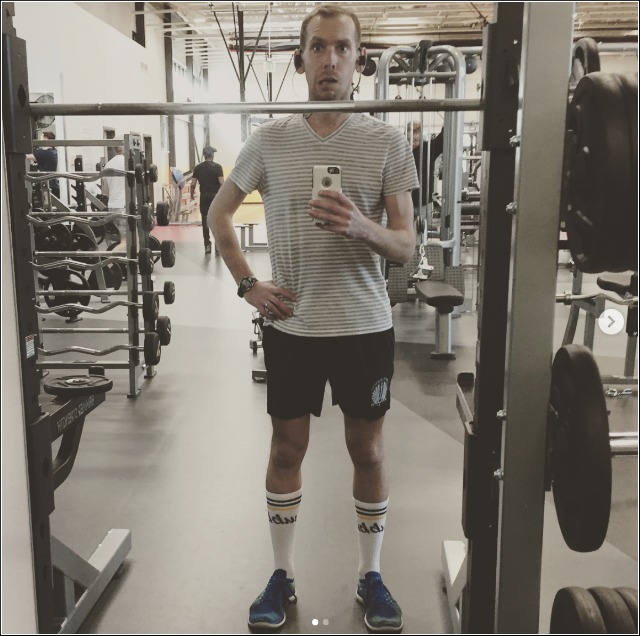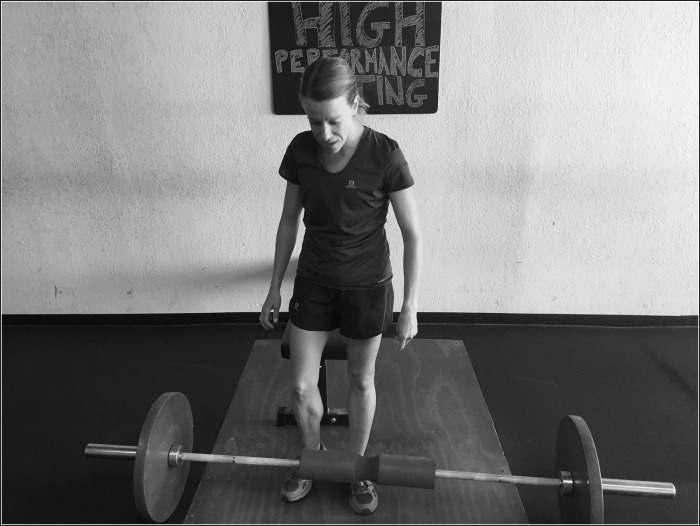Runners have a nearly endless selection of exercises, routines, workouts, and classes to plan their strength training. But how can they decide how best to get stronger as a runner?

Having fun with my strength training…
When you try to plan strength training for runners, it must have two major characteristics:
- The focus is on multi-joint, compound movements (like squats). We’re not doing isolation exercises like bicep curls because we’re not body builders.
- The goal is strength, power, and injury prevention (not endurance or hypertrophy)
For most runners, the biggest benefit they’ll experience from adding strength training to their program is injury prevention. They’ll be able to tolerate higher mileage levels, more challenging workouts, and longer long runs.
And more training almost always results in faster, stronger, more capable runners!
That’s because with stronger connective tissues, muscles, and more resilience to fatigue (and the inevitable break-down in form that comes with it), runners are much more effective at mitigating the impact forces of running.
But alas, runners are not necessarily experts at strength training. In fact, most of us shun the weight room and would rather be running outside than picking up a barbell (myself included)!
There can be questions about how best to start strength training, which exercises are ideal, and how to plan them into your training.
And we’re here to help.
Step 1: Bodyweight Strength Exercises
If you’re brand new to strength training, you shouldn’t jump into a difficult weightlifting workout in the gym with heavy plates. It’s best to get comfortable with bodyweight exercises to establish some competence and strength first.
For runners, ideal bodyweight strength exercises include:
- Squats
- Lunges
- Single-leg deadlifts
- Push-ups
- Planks
- Bridges
These are all simple, basic movements that all runners should be able to do provided an existing injury isn’t limiting what the athlete is capable of doing during training.
Bodyweight exercises such as these also have an added benefit: there exist nearly unlimited variations to keep things fun and interesting.
For example, a runner could implement a whole variety of squats to improve strength in different ways, improve athleticism, and prevent strength gains from stagnating:
Bodyweight exercises are not incredibly demanding, so a 10-20 minute strength routine can be completed after most runs during the week. The workout will act as a cool down in addition to helping the runner get stronger.
Some of my favorite, “bread and butter” routines for runners include:
You’ll see that most of the exercises in these routines are bodyweight. But some include bands (I recommend a good Theraband) or a medicine ball (a great inexpensive purchase to invest in your strength goals).
But while bodyweight exercises are good, weighted exercises are better.
And an ideal strength training program for runners will include a healthy mix of both for best results.
The Next Step: Weightlifting

After a runner has gotten comfortable performing several bodyweight strength training workouts per week, the next step is layering more formal weightlifting workouts into the program.
Bodyweight exercises can be done after every run, but more traditional weight training in a gym should be done about twice per week after running.
Since you’re lifting heavier weight (rather than your own body weight), you’ll need to take more recovery in between exercises. That’s why gym workouts typically take longer than bodyweight sessions at home.
Ideal weightlifting exercises include:
- Squats
- Deadlifts
- Presses
- Power Clean
- Snatch
- Clean and Jerk
You’ll notice that several of these exercises are the same as the bodyweight exercises. That’s because these movements are fundamental and should also be used with weight in the gym.
But some of these exercises are very different. They’re Olympic lifts – also called power lifts.
Exercises like the Power Clean are more closely tied to speed because they’re explosive, requiring the recruitment of more muscle fibers to accomplish the lift. They build power, speed, and explosivity that directly help you sprint faster.
They also make your running form more economical by programming your central nervous system to more efficiently coordinate which muscle groups to fire and which to relax. This intra-muscular coordination helps you have a smoother stride.
And much like the running portion of your training, strength work should also be progressive and periodized.
Progressive training means that it changes – or progresses – over time. In other words, it starts at a level that’s appropriate for the athlete and moves her closer to where she’d like to be (Faster! Stronger! Smoother!).
Periodized training means that its focus changes over time as well. At the beginning of a lifting program, the goal is general strength and injury prevention. But at the end of a lifting program – when the goal race is approaching – the focus shifts to power, speed, and coordination.
We go into far more detail on this level of strength training for runners here.
How to Plan Strength Training
For most runners, two days in the gym with a 45 – 60-minute structured weightlifting workout is ideal. Since these workouts are more challenging than bodyweight routines, they should be scheduled on your harder running days like a faster workout and long run.
This helps make your easy days easier, but your hard days harder. Polarizing your training in this ensures you’re focusing on recovery on your easy days and gaining as much fitness as possible on your hard days.
On the other running days throughout the week, a bodyweight routine that focuses on runner-specific movements (targeting the hips, glutes, quads, and hamstrings) is sufficient. These workouts can be substantially shorter at 10 – 30 minutes.
Transitioning to heavier weights in the gym in a more structured “weight lifting” environment is how to get the powerful, full benefits of lifting:
- Neuromuscular coordination and enhanced running economy
- Power and the ability to recruit a higher number of muscle fibers
- Improved mitochondria development and testosterone production
- Stronger hypertrophy stimulus – preserving precious muscle mass
These are significant adaptations to lifting weights that won’t happen with bodyweight exercises. The stimulus simply isn’t strong enough.
Sign up here and you’ll get Strength Running’s free strength course. We’re going to cover a lot:
- The many reasons (even more than you realize) for starting a weight lifting routine
- Why bodybuilding and endurance workouts are a waste of time
- The type of exercises that build power, explosivity, and fast-twitch responsiveness
- The exact progression of exercises, sets, and reps that’s ideal for runners
- A video presentation that’s never before been public
Get it all here – your first lesson will be in your inbox within 5 minutes.